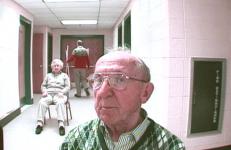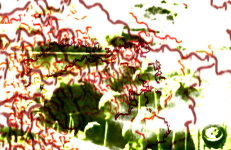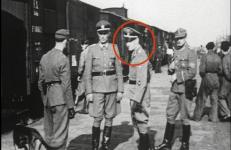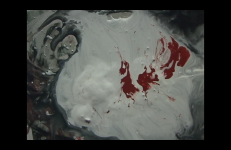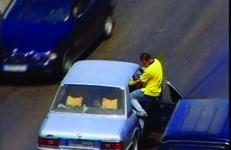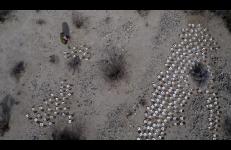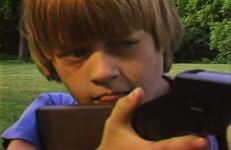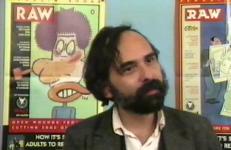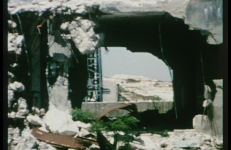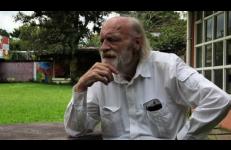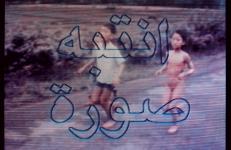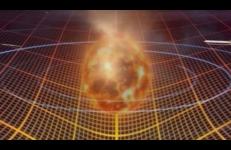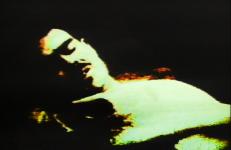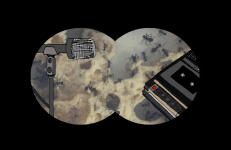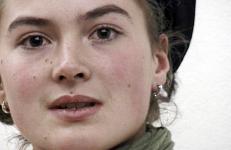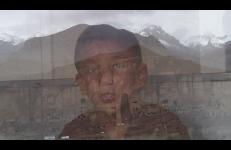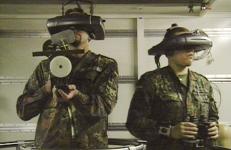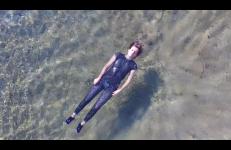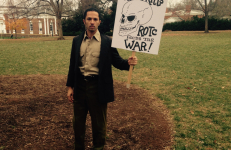A video adaptation of James Joyce’s Ulysses shot at the Parkville Senior Center, Connecticut, with the seniors reading the lines from cue cards. The piece addresses society, war, and personal mortality.
War
The PSA Project No. 1-15 is a series of fifteen videos that speak out against the U.S. occupation of Iraq and the act of war.
Respite consists of silent black-and-white films shot at Westerbork, a Dutch refugee camp established in 1939 for Jews fleeing Germany. In 1942, after the occupation of Holland, its function was reversed by the Nazis and it became a 'transit camp.' In 1944, the camp commander commissioned a film, shot by a photographer, Rudolph Breslauer.
"A major influence for generating ideas for me was not what I could contrive on my desktop, but being open and receptive to “accident”. For instance, one evening in 1972 while typing a syllabus for a class on my old Smith Corona typewriter, I happened to see on the TV a documentary by Leni Riefenstahl. German troops were marching, and I found that I could duplicate the “ta ta tum, ta ta tum, ta ta tum tum tum” of the drumbeat by typing “mar mar march mar mar march.“ Had not the broadcast of this film taken place while I was typing, I would never have thought of this concept.
Rosa juxtaposes the life of the filmmaker in two extreme locations (Baghdad and Montana) through three elements of nature: dust, rust and wind. The filmmaker uses these elements as a poetic introduction to navigate memories of his past and to compare them to his Montana present.
Joe Sacco is a cartoonist who has contributed to a wide range of comic magazines including Drawn and Quarterly, Prime Cuts, Real Stuff, Buzzard, and R. Crumb’s Weirdo; he continues to illustrate the semi-regular Painfully Portland cartoon strip for the Willamette Week. He was a recipient of the prestigious American Book Award in 1996 for his work Palestine (1996), which combines techniques of eyewitness reportage with comic strip storytelling.
Following the Israeli attack on Lebanon in 2006, the filmmaker examines the boredom of everyday life in a besieged country.
This title is only available on Radical Closure.
Scenes from an Endless War is an experimental documentary on militarism, globalization, and the "war against terrorism." Part meditation, part commentary, Scenes employs recontextualized commercial images, rewritten news crawls, and original footage and interviews to question received wisdom and common sense assumptions about current American policies.
Security Anthem’s requisite components came together relatively slowly. I’d known for years that I wanted to make something out of the Oto speakers’ most sinister, suggestive sentences. I’d taught myself to program music on a Game Boy using a cartridge I’d bought from a Swedish programmer, and I composed a sequence of ominous music that seemed well-matched to the speakers. I’d recorded John Ashcroft singing his self-penned song “Let the Eagle Soar” through a media player window, and I knew that it somehow belonged with the speakers and the 8-bit music.
Ireland, October 20th 2007
The filmmaker returns to the city where he made the first video in the series and looks back at the events of the past six years.
Six Years Later is the eighth episode in the Hotel Diaries series, a collection of video recordings made in the world’s hotel rooms, which relate personal experiences and reflections to contemporary conflicts in the Middle East.
The Sky Is Falling... is part of an ongoing series of performances that make up The Data Humanization Project.
Smothering Dreams is a tough, scathing condemnation of war and our country's fascination with violence. Reeves draws on his own experience as a U.S. Marine in Vietnam in the 1960s, juxtaposing actual combat footage, staged war games, and child’s war play to make his message horrifyingly clear. This work is dedicated to the men of the 3rd Platoon Company A 1st Amtrac Battalion and the North Vietnamese soldiers who died on January 20, 1969 along the Cua Viet River.
Art Spiegelman was born and raised in New York, and began working as a cartoonist while still in High School. He attended the State University of New York in Binghamton, where he studied Philosophy. Spiegelman, who continued to work as a cartoonist, mainly in underground publications, throughout his schooling, has long been acknowledged as one of our era's foremost comic book artists. However, it was Maus, published in two volumes in 1986, that first brought his work to a mass audience. Maus tells the stories of a Jewish survivor of Nazi Germany and his son.
Still Life gazes unflinchingly at the violence of war, observing the West Bank and Gaza Strip collapsed under Israeli occupation. This portrait provides brutal witness to how government sanctioned destruction metes upon structures of home and State.
Directed by Cynthia Madansky
Music by Zeena Parkins
The violent overreaction to 9/11 and to the revolutions of the 1960s cannot be explained only with fear and politics. Franz Hinkelammert, a German-born liberation theologian, economist and philosopher, brings religion front and center to the discussion in a unique way. The emptiness and senselessness felt by those at the margins of a free-market utopian ideology has been filled by an extreme millenarian Christianity and other religious fundamentalisms that justify murder and torture as preemptive self-defense.
An episode from a Lebanese TV series entitled Image + Sound. Each episode in this groundbreaking program was based on paralleling TV news images alongside staged events. This episode was shot at the St. Georges church in Beirut before its renovation.
"In The Very Very End, Barber points to his medium's plastic possibility by somehow traveling into the future and the past, nodding to Neville Shute's apocalyptic 1957 novel On The Beach, while setting an end-of-days story in a 21st Century holiday resort.
Shot in Lebanon, Syria and Jordan, this essay uses transportation, video, and photography to examine images circulating in a historically charged, and presently war-torn and divided, Middle East. From images of camels in the desert to images of the Arab-Israeli conflict, the video looks at states of mind in relation to actual geographies. The video pays tribute to an unformatted and open-ended documentary approach, and examines modes of access to information such as travel, television and the Internet, while carefully displaying the resulting iconography.
“A short image-processed work, Thousands Watch deals with the issue of nuclear suicide. The tape’s central metaphor is derived from a 1936 Universal newsreel of a crowd looking on while a young man stands on the ledge of a tall building, threatening to—and eventually succeeding in—committing suicide. It begins with an image of time-lapsed colorized clouds racing across the sky at a frenzied pace while a low siren wail emerges on the soundtrack. This sound forms a pulsing heartbeat and builds into a tense crescendo as the tape progresses.
A film about people trying really hard to listen and people hardly listening.
Produced in former Yugoslavia (Bosnia-Herzegovina, Croatia, Macedonia, Serbia & Montenegro, Slovenia), Austria, USA, Canada, 1999-2003.
Out of the mouths of rural boys, finding the incomparable Mulla Nasrudin in Afghanistan.
Since the Gulf War in 1991, warfare and reporting it have become hyper-technological affairs, in which real and computer-generated images cannot be distinguished any more. With the aid of new and also unique archive material, Farocki sketches a picture of the relationship between military strategy and industrial production and shows how war technology finds its way into everyday use.
-- International Film Festival catalogue, Rotterdam (2004)
Every country employs specific techniques for disguising its soldiers, every army has developed its own camouflage uniforms. Croatia is one of the few countries in the world that uses a digitized shape of its own territory in its camouflage military design. Why? The question is not meant to be answered by human reason. It does not relate to the perception of human eyes. Night vision cameras, binoculars, heat detectors and drones have their own ways of seeing the world.
The story of the anti-Vietnam War movement from the perspective of James R. Roebuck, the first African American president of University of Virginia’s Student Council. Over a ten-day period of unprecedented student upheaval in 1970, Roebuck confronted a series of political challenges and existential dilemmas. This budding activist and future U.S. representative was the quintessential militant insider whose cool temperament and ideological flexibility proved quite useful as UVA appeared on the verge of imploding from within.




